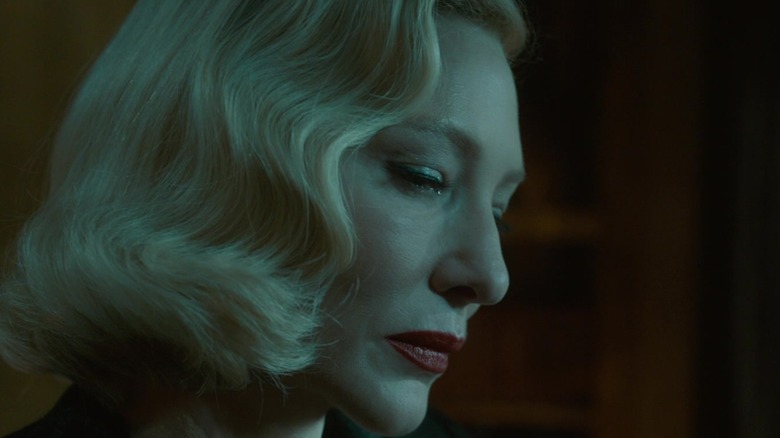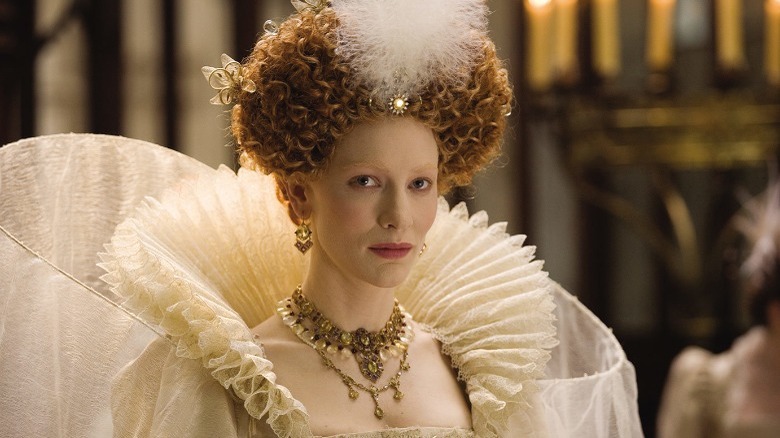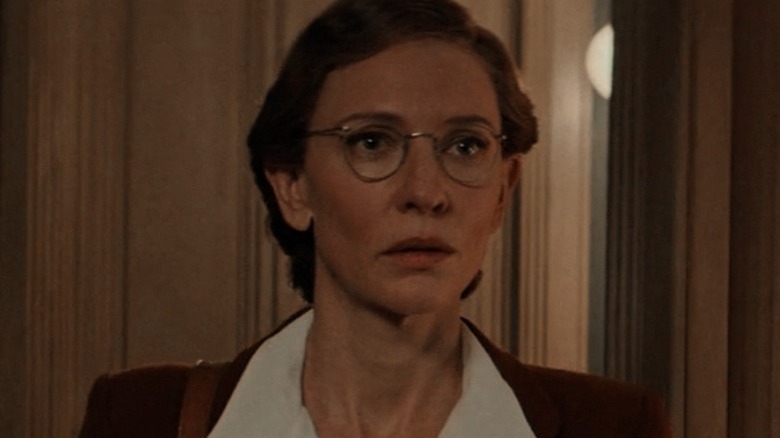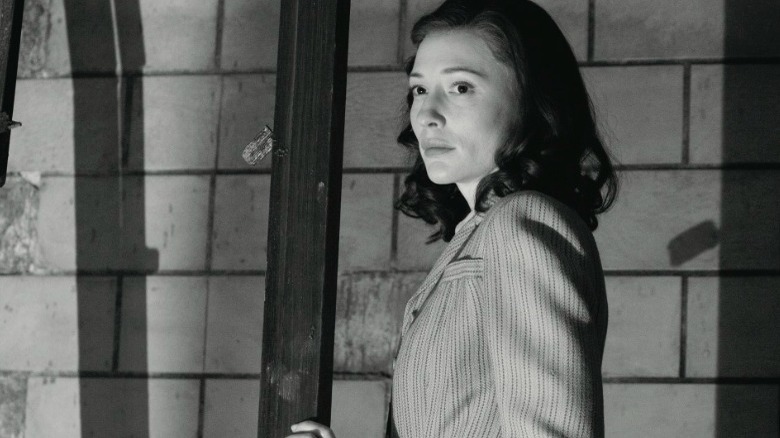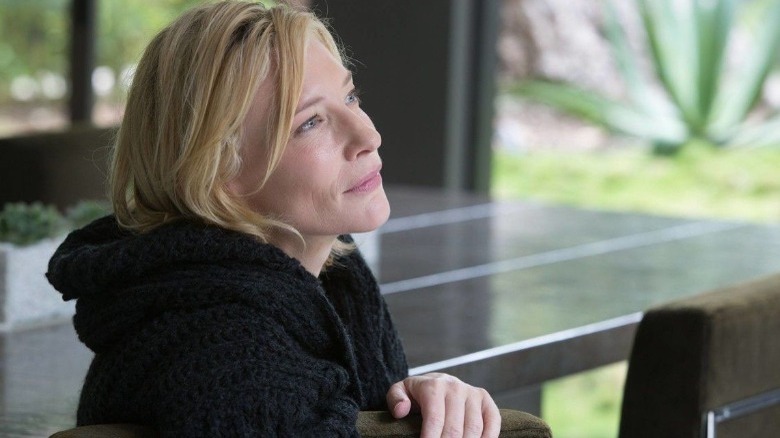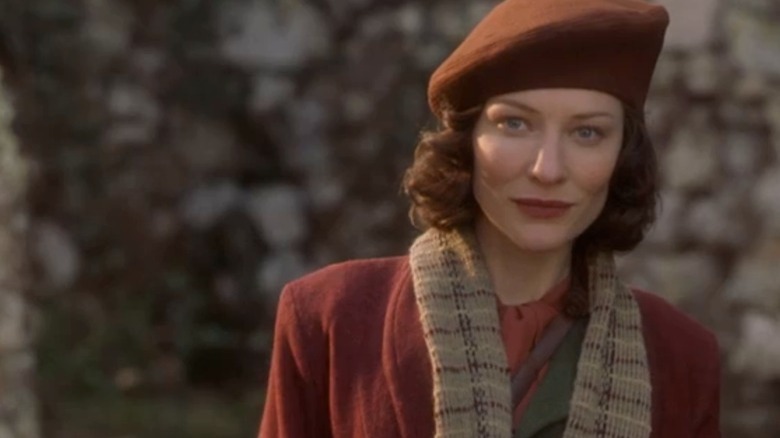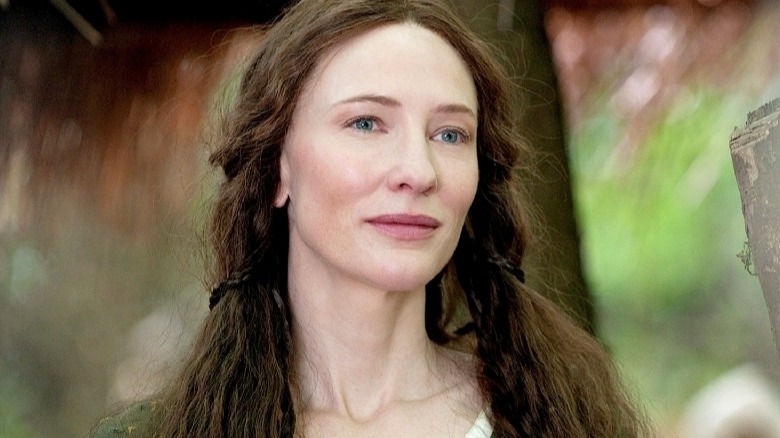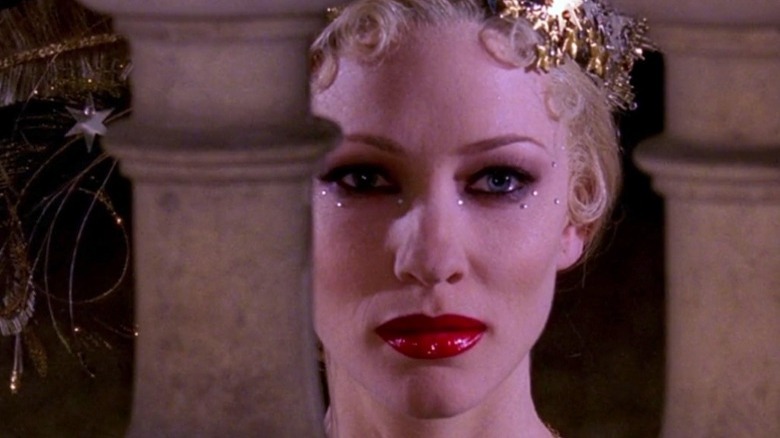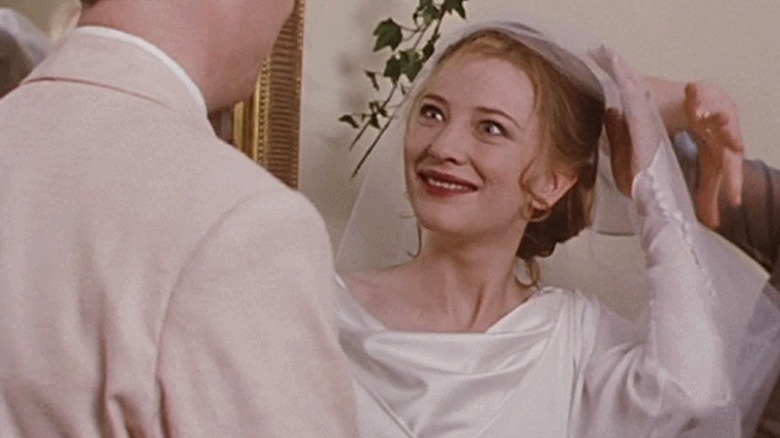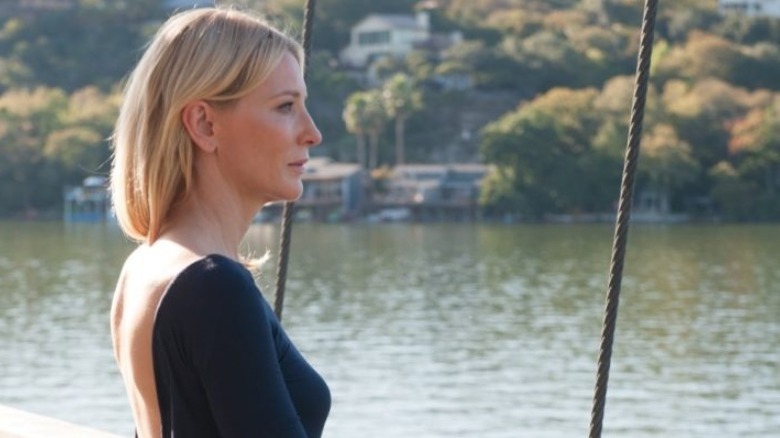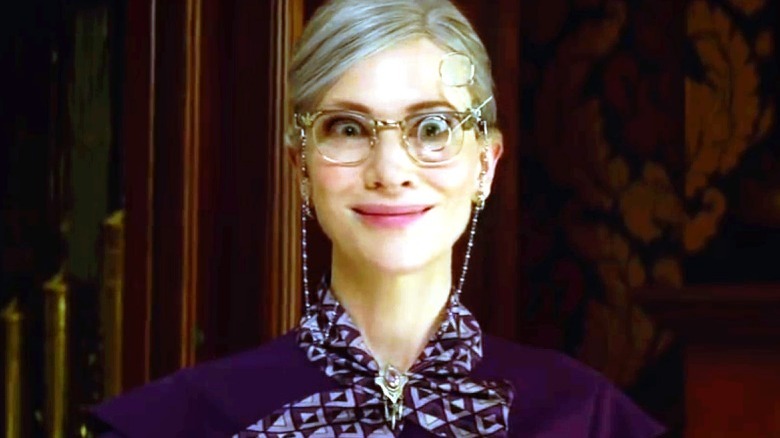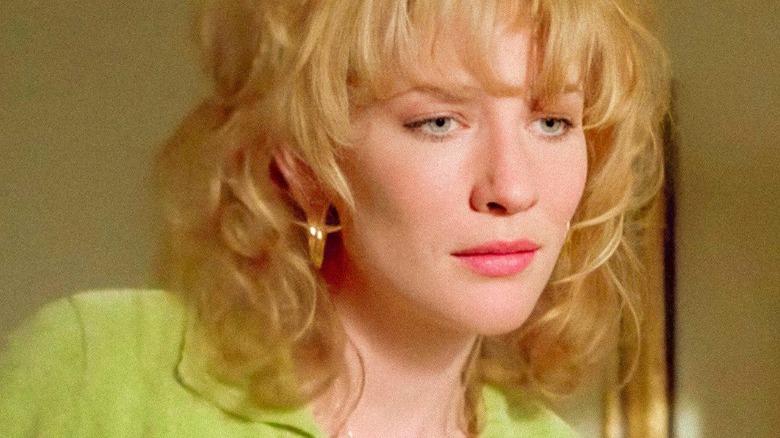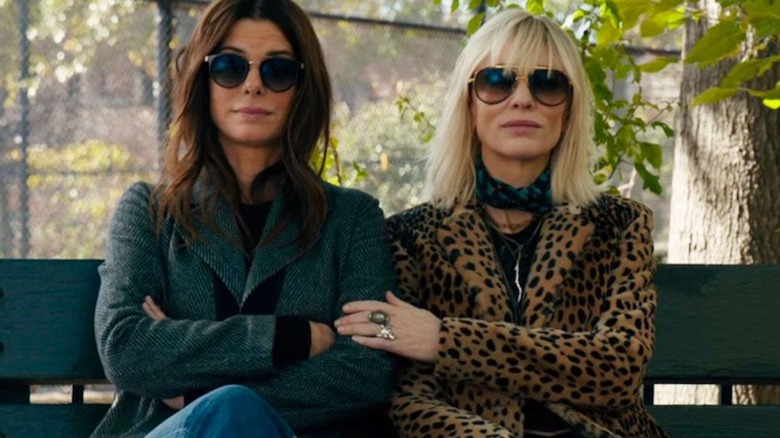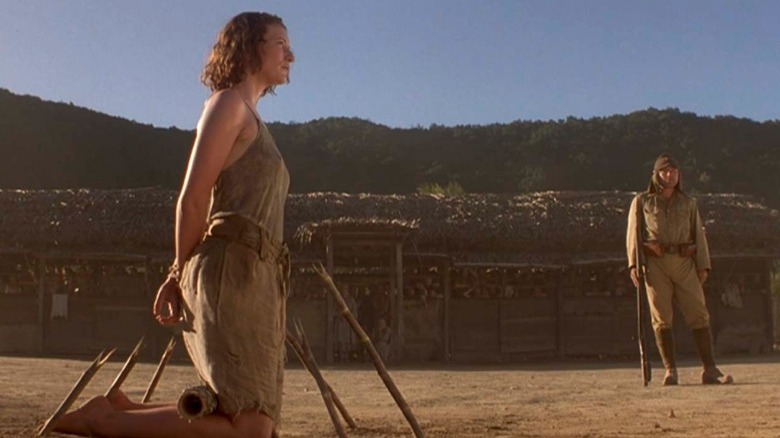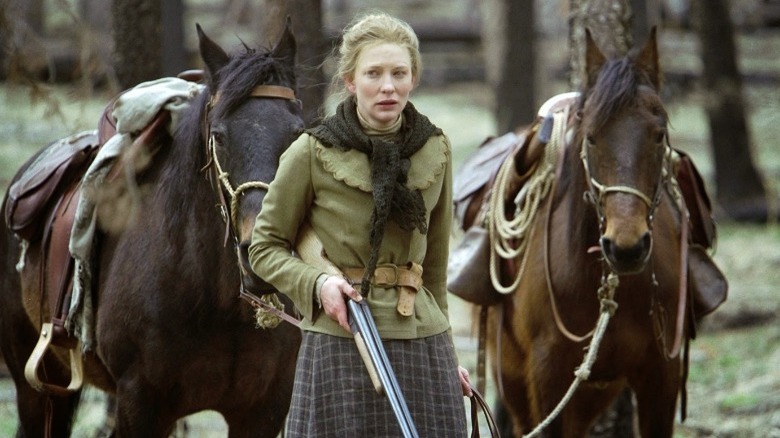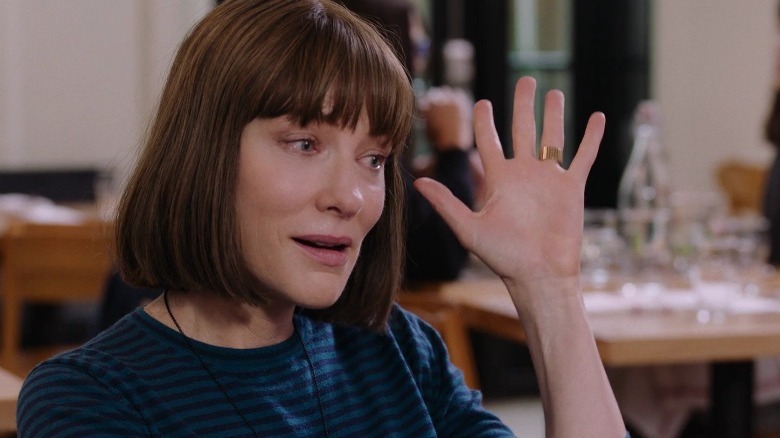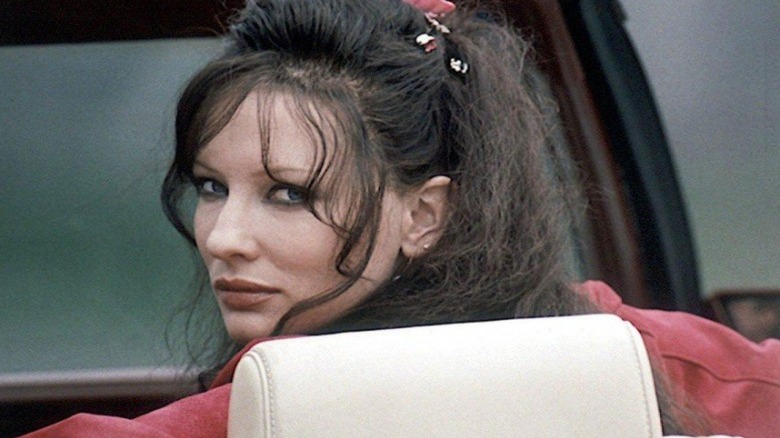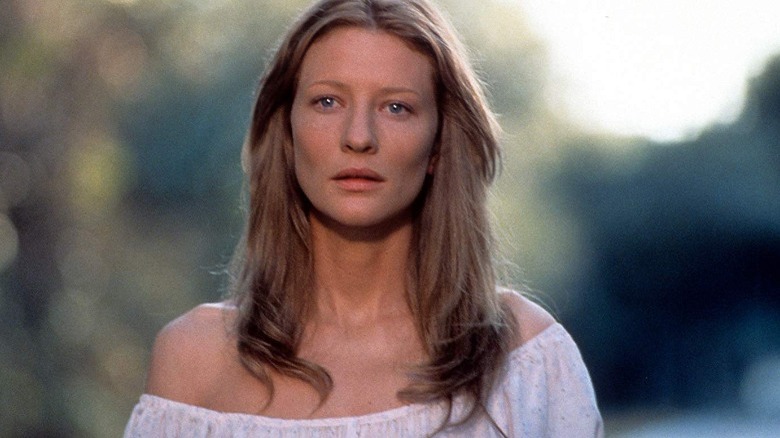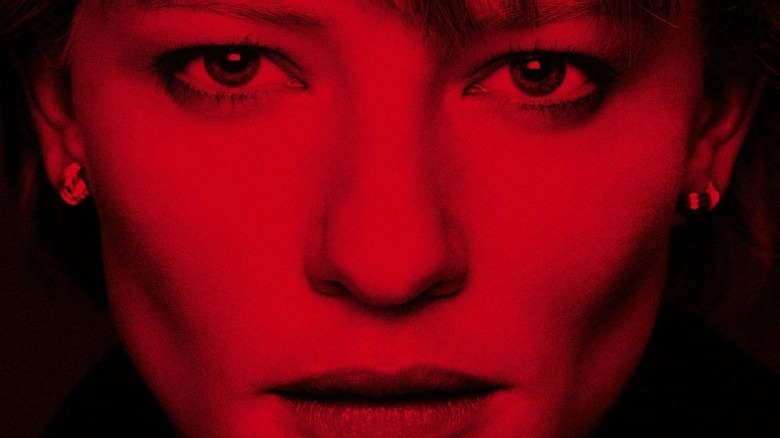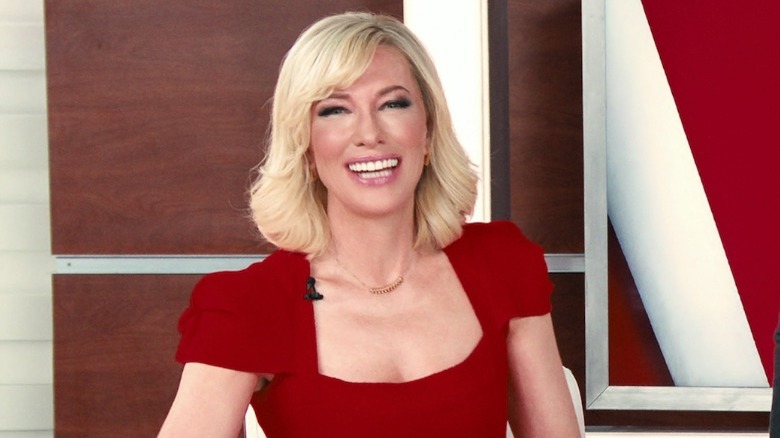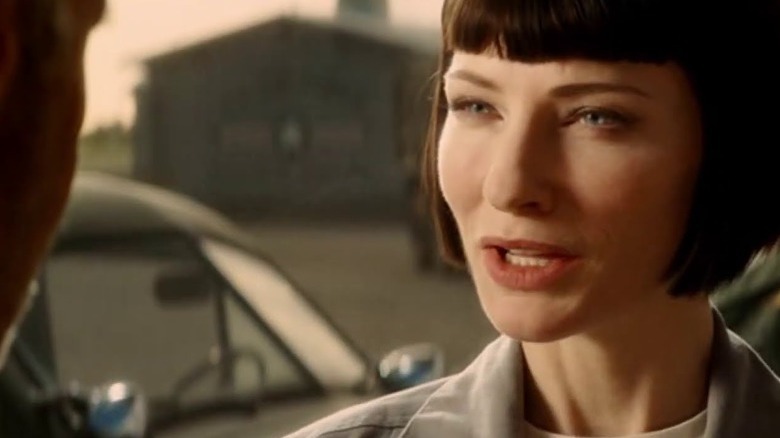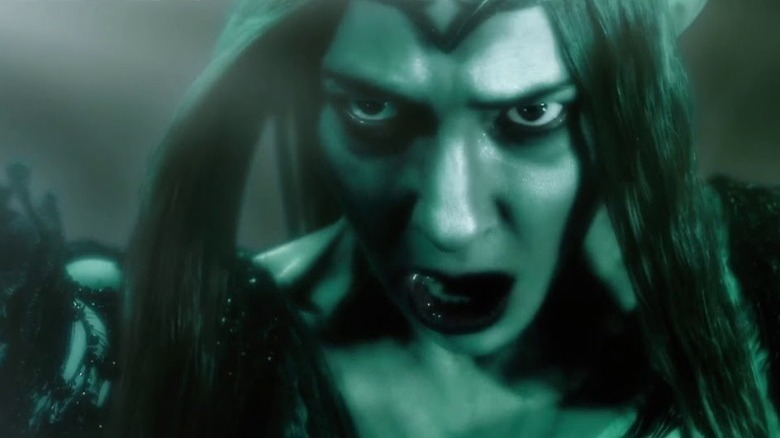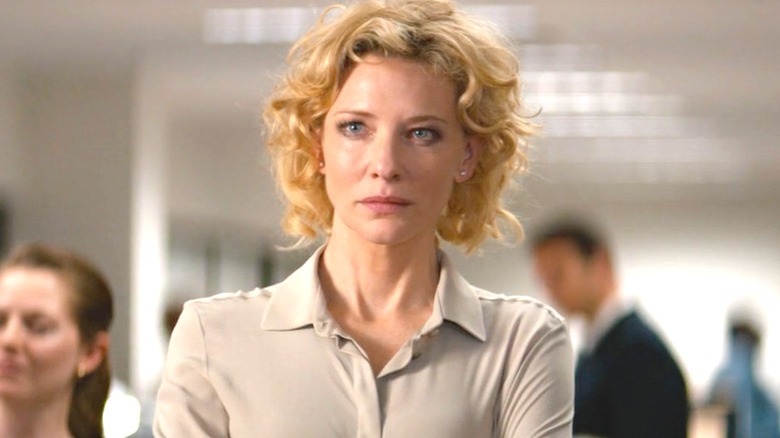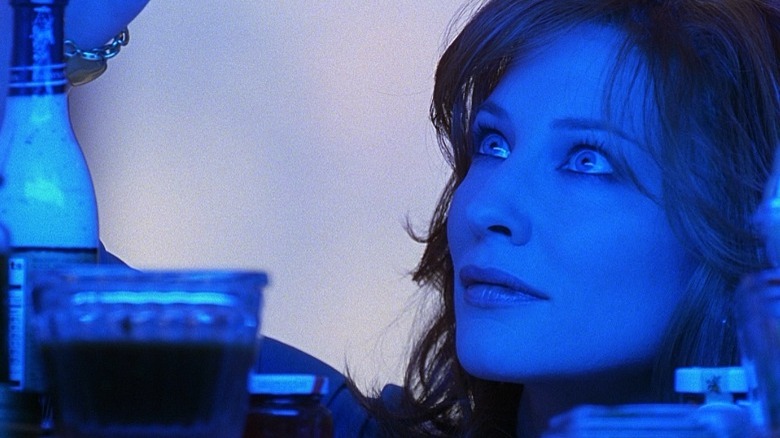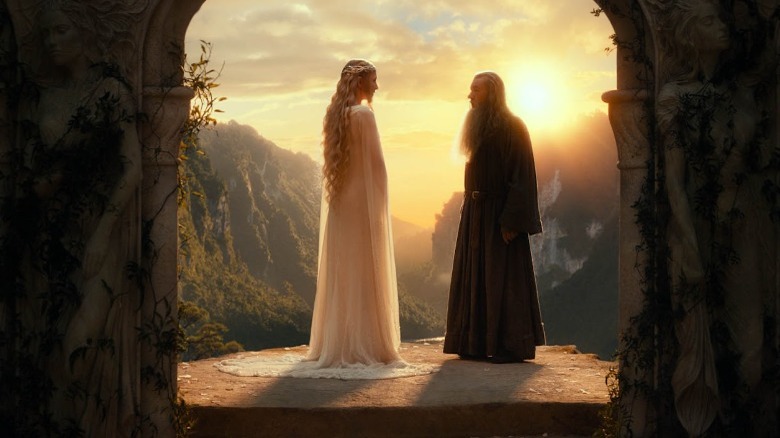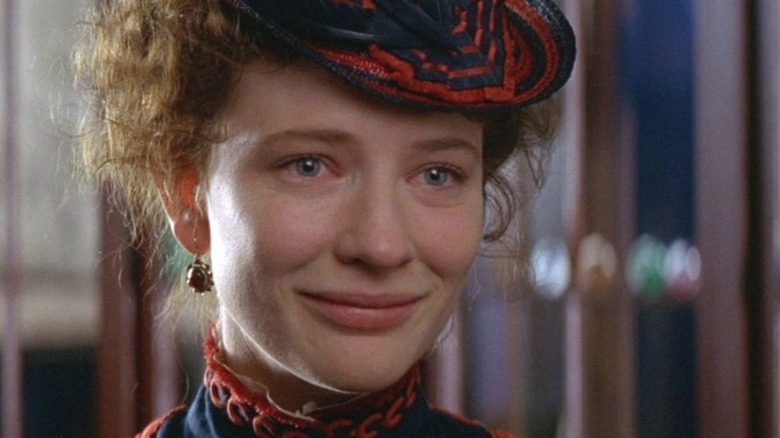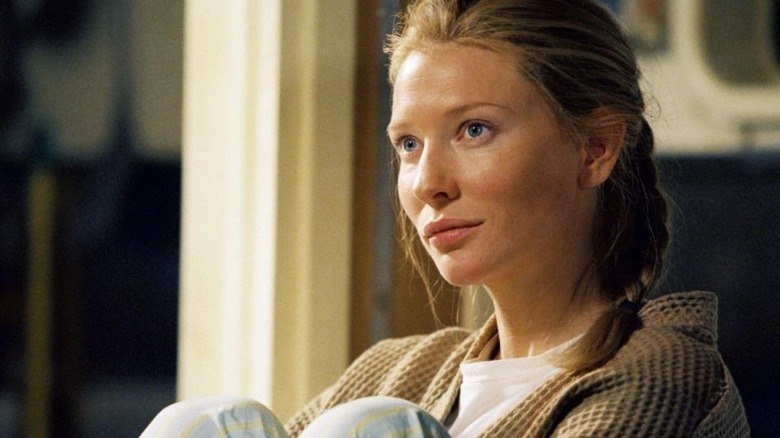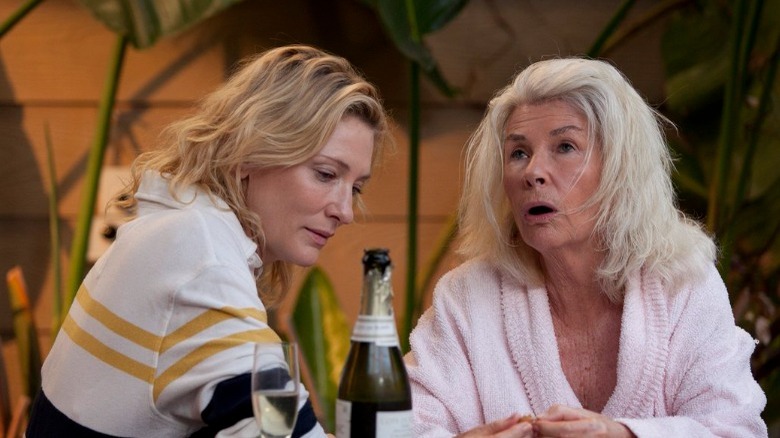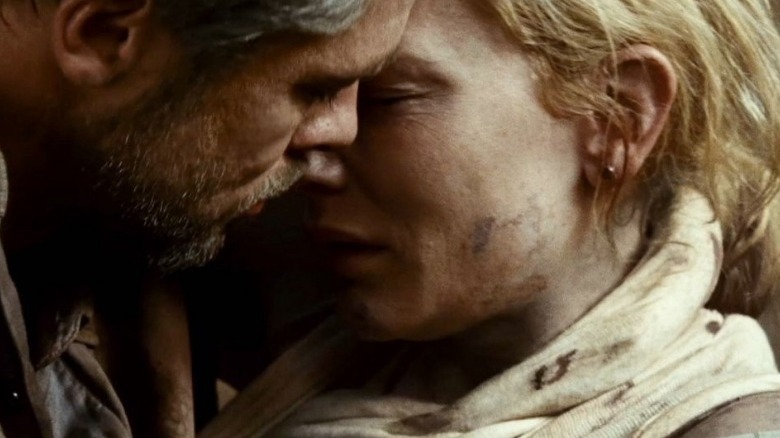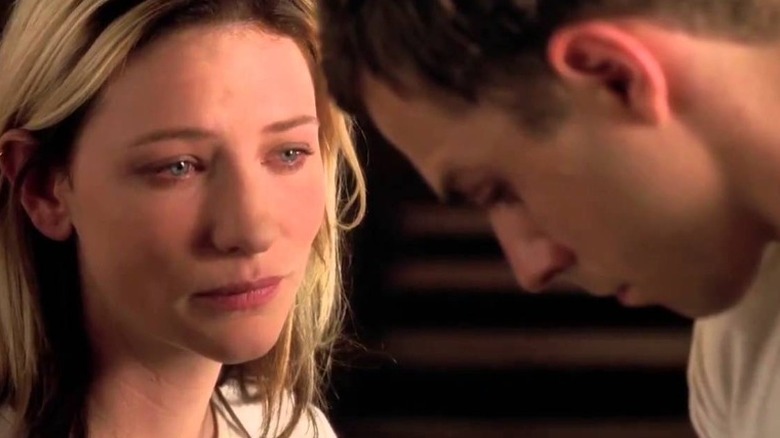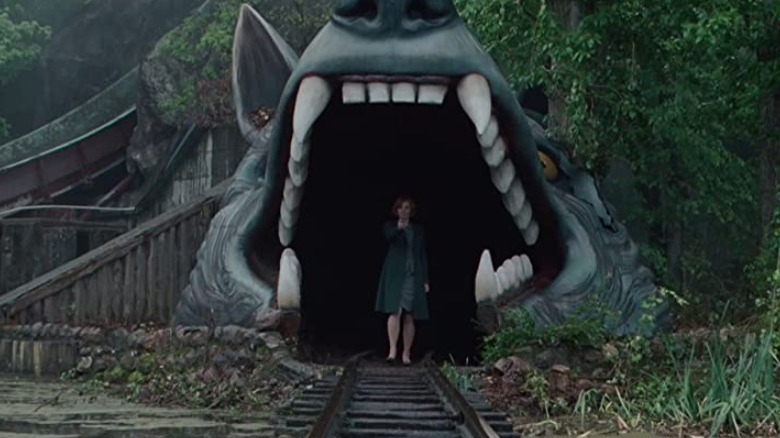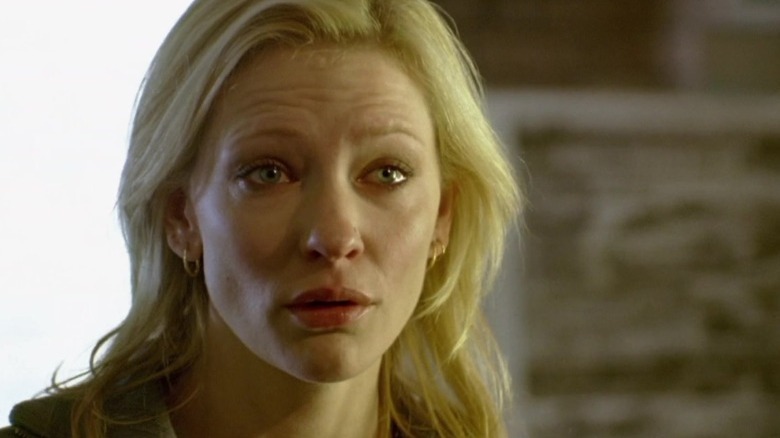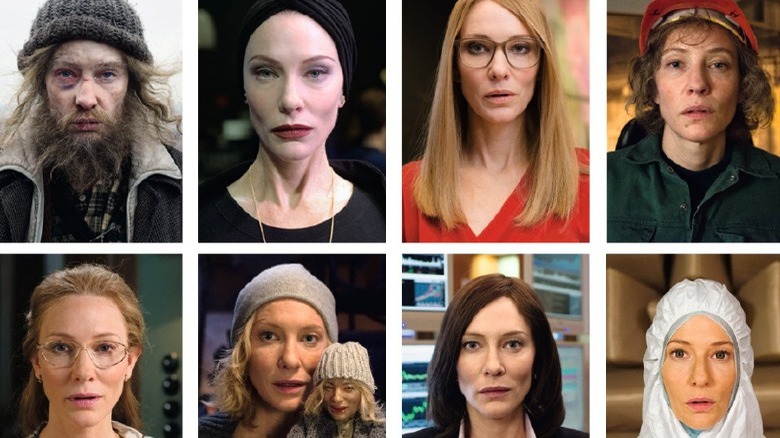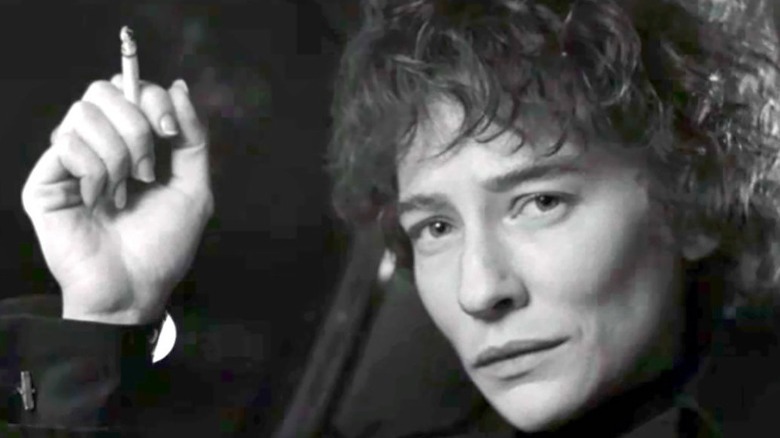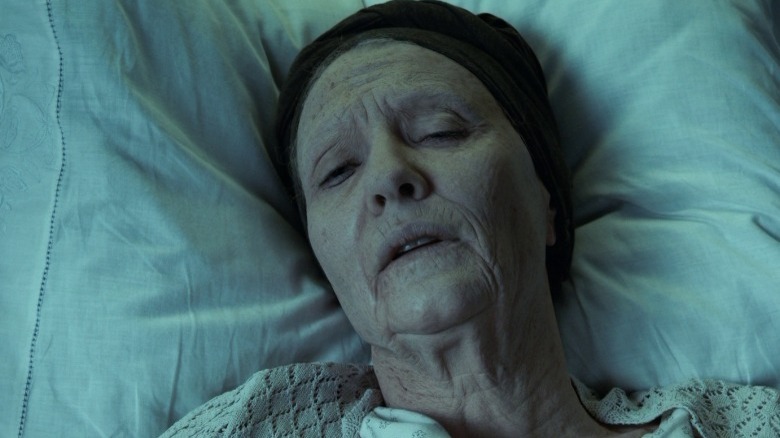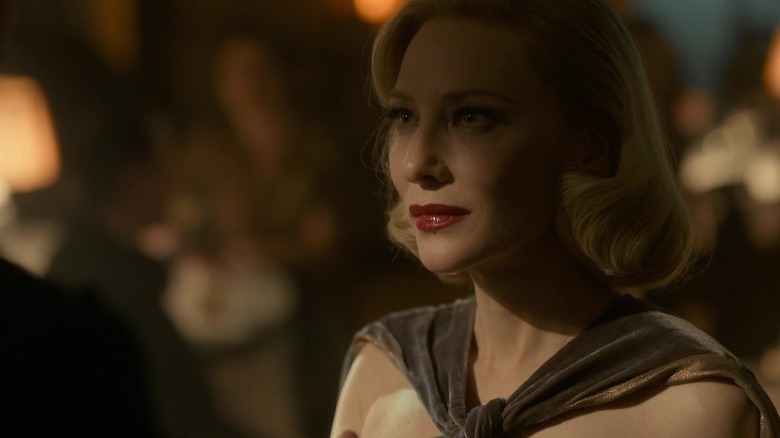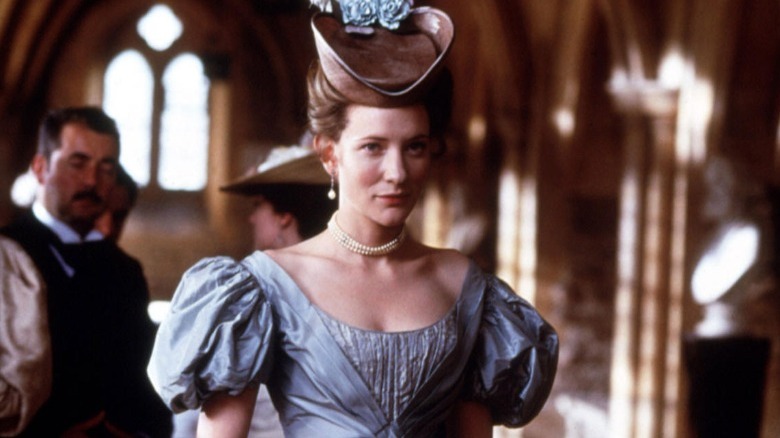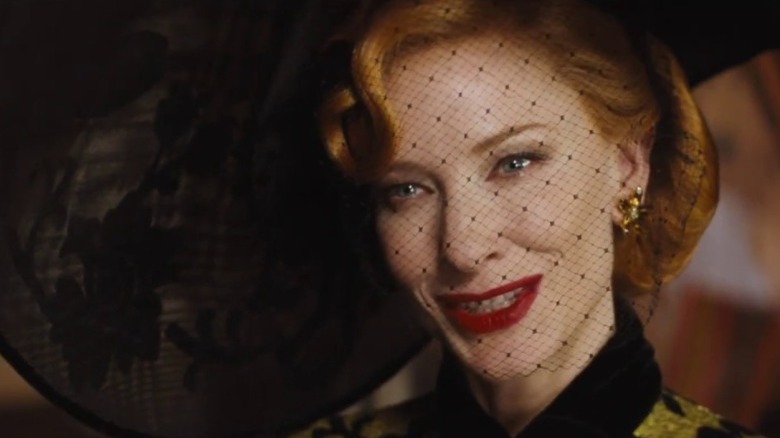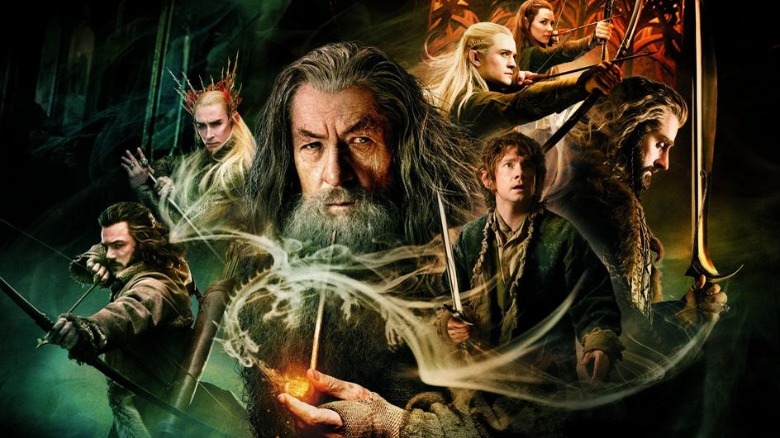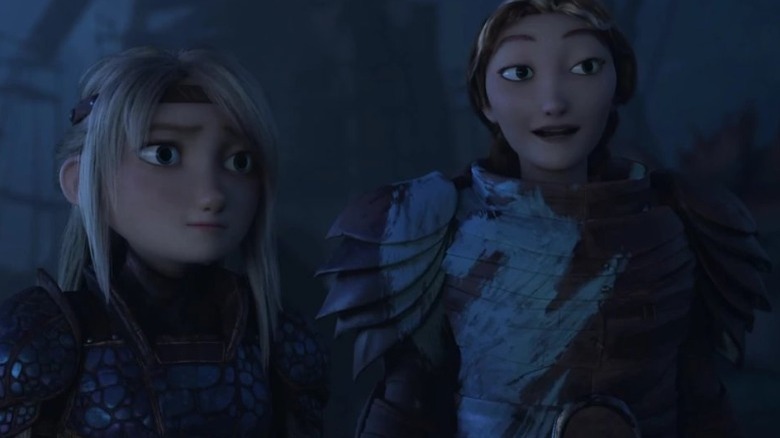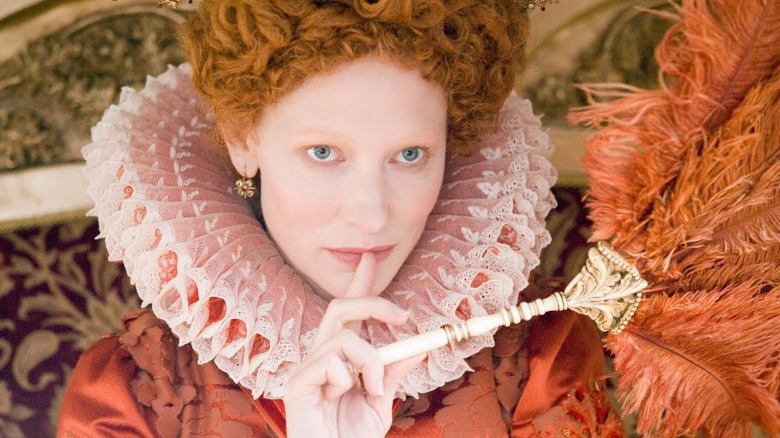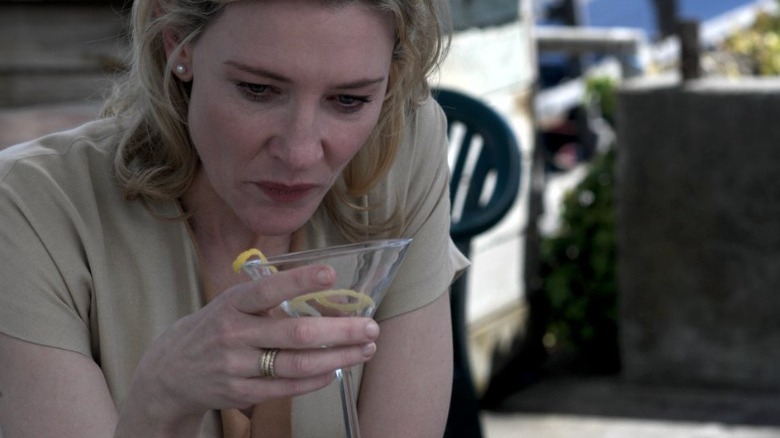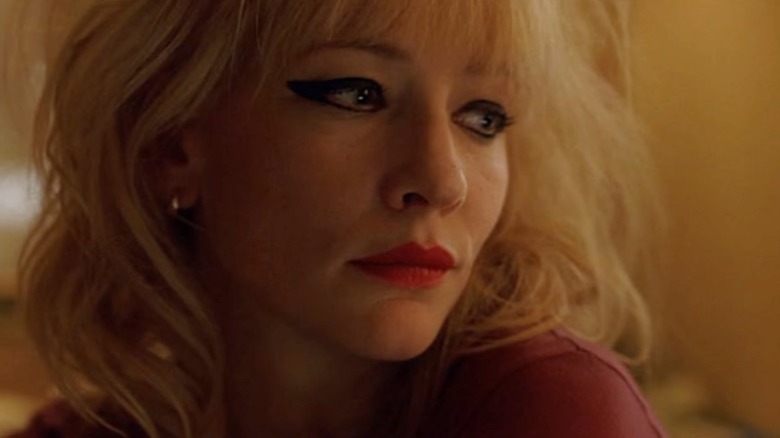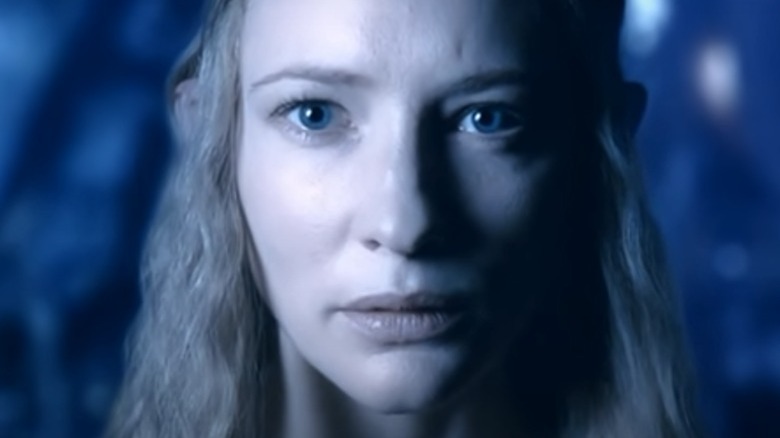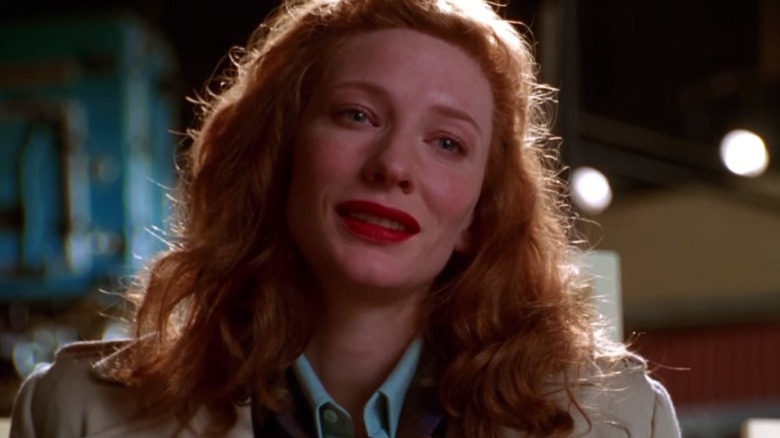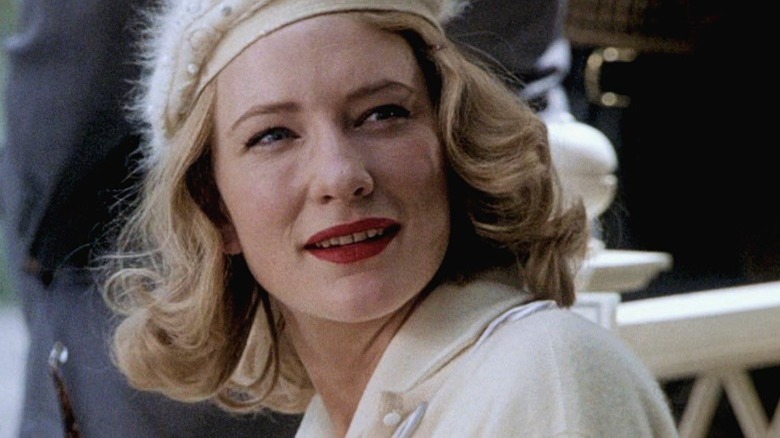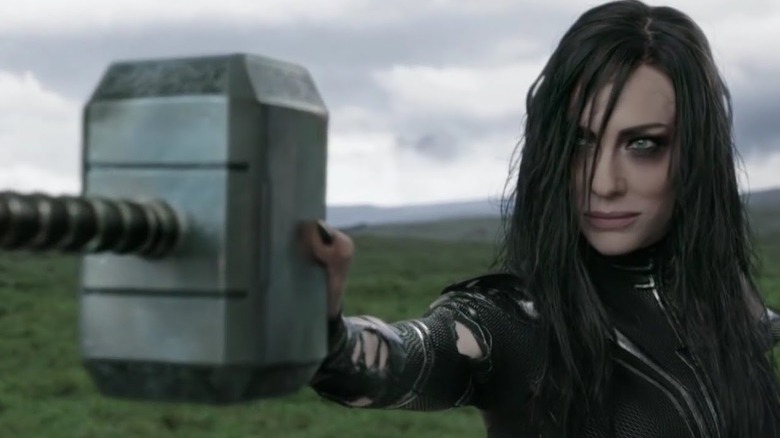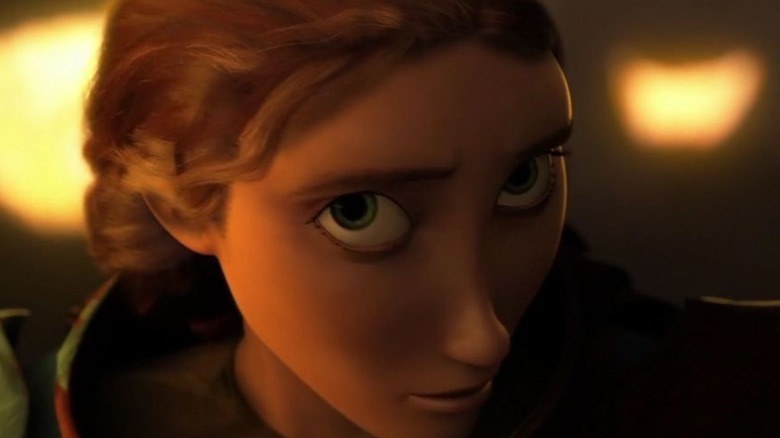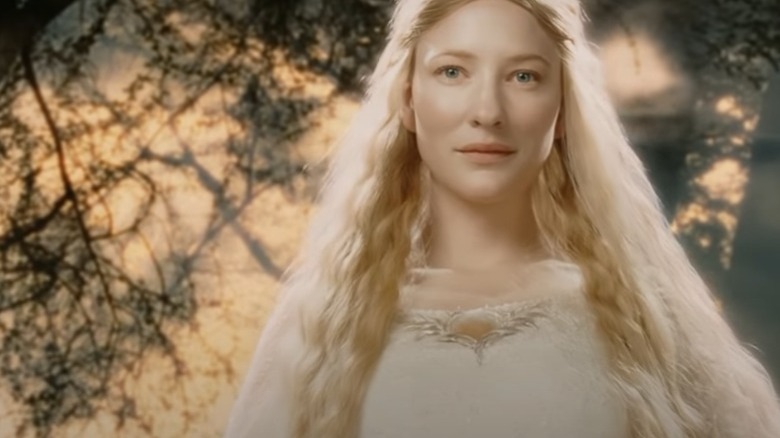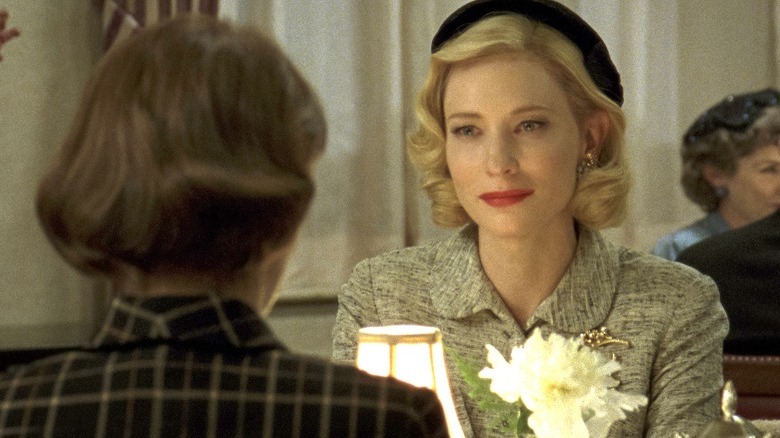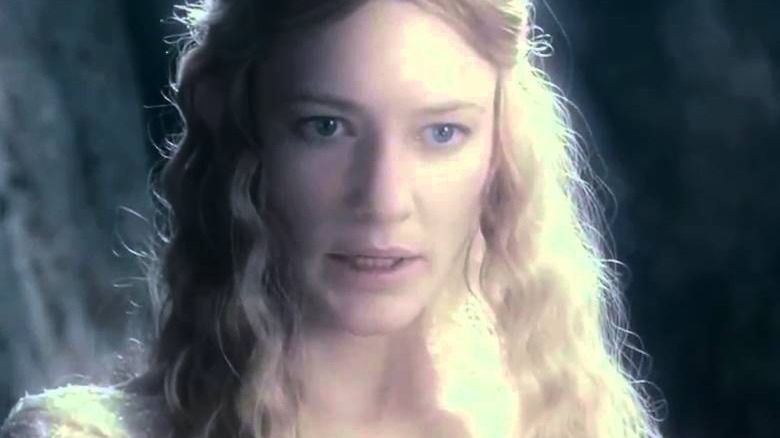Every Cate Blanchett Movie Ranked Worst To Best
Cate Blanchett has the uncanny ability to steal the entire movie. Sometimes, she openly swipes it from her fellow actors, while other times she's more sneaky about it, but at the end of the day, says The Vulture, "every Cate Blanchett movie has been A Cate Blanchett Movie." Even in a terrible film, Blanchett somehow always manages to be the highlight and the saving grace.
Blanchett's favorite word is "fluidity," according to The New Yorker, and her filmography makes this apparent. She's played just about every type of role imaginable. Evil stepmother? Check. Katharine Hepburn? Check. She's even delivered an incredible turn as Bob Dylan.
We're going to examine each one of Cate's roles, ranking them from worst to best. Of course, we're going to be excluding Blanchett's documentaries, as well as any project where she plays herself. We won't include any of her voice-over roles, except for the "How to Train Your Dragon" movies, which are among some of Blanchett's best-rated films. Even without the titles mentioned above, Blanchett still stars in no fewer than 50 movies.
50. Elizabeth: The Golden Age
As the sequel to the much-lauded 1998 film "Elizabeth," "Elizabeth: The Golden Age" suffers a dramatic dip in quality. So dramatic, in fact, that it earns the honor of being the worst Cate Blanchett film. In 1585, Queen Elizabeth I (Cate Blanchett) must defend her country against an invasion from Spain, which intends to place Mary Stuart (Samantha Morton) on the throne.
According to The Atlantic, "the first film was about a frivolous girl who became an iron-willed queen," but the sequel sees Elizabeth making the opposite transformation, as she flirts with and quickly becomes upstaged by Walter Raleigh (Clive Owen), who in real life was nowhere near as swashbuckling as the movie makes him out to be. Blanchett "certainly has the royal chops" for the job, says The Guardian, but the film is a royal mess in spite of her best efforts. The film is guilty of historical inaccuracies and gross oversimplifications, especially in its portrayal of Catholic Spain. Matt's Movie Reviews calls the film "a one-sided version of history, painted with the broadest of strokes."
49. The Monuments Men
"The Monuments Men" had so much potential: a compelling premise drawn from real-life events, an all-star cast that included George Clooney and Bill Murray, promising themes about how crucial art is to the survival of civilization. So what went wrong?
Part of the problem, according to the Los Angeles Times, is that this film is too ambitious. It can't decide what genre it wants to be: a moving war drama about some untrained civilians rescuing beloved classic artwork from the Nazis or a buddy comedy about a team of bantering Monuments Men. The Arts Fuse adds that the film doesn't give much thought to why it's so important to save the artwork, which only serves as a MacGuffin to drive the plot forward.
Naturally, Cate Blanchett's scenes rise head and shoulderms above the rest of the film. She plays Claire Simone, the museum curator who risks her life to keep tabs on the Nazis. IGN goes so far as to say that it might have been ore interesting to see an entire movie about Blanchett's character.
48. The Good German
Director Steven Soderbergh went to great lengths to shoot this 2006 film noir as if it were a movie from the '40s, right down to the "boom mics and fixed lenses," says Variety. The effort put into the film's visual style is admirable, but critics agree that it's not enough to save this movie.
In the wake of World War II, Jake (George Clooney) heads to Berlin to investigate the murder of a U.S. driver (Tobey Maguire). His biggest lead is German woman Lena Brandt (Cate Blanchett), a former lover.
According to Film Critics United, the movie is riddled with plot holes (namely, why does Jake follow Lena so blindly when it's clear she's not telling him everything?), but Blanchett is such a talented actress that she's easily the highlight of the film. Sundays with Cate agrees, saying it's one of Blanchett's "most underrated" roles. First Showing concludes, "'The Good German' will let you relive your noir fantasies, at least if you're willing to ignore some confusing plot issues and deliberately overwrought acting."
47. Knight of Cups
Terrence Malick's "Knight of Cups" doesn't have an official plot, per se, but focuses on an aimless screenwriter (Christian Bale) who bounces from woman to woman and grasps for some kind of meaning in his life. Even that description "makes it sound much more understandable than it is," according to Kenneth Turan from The Baltimore Sun; the fragmented non-narrative borders on the incomprehensible. The cinematography is inventive, says Turan, but that's about all that can be said for this film that seems painfully unaware of its self-important smugness.
The Guardian points out that "Knight of Cups" objectifies the female body in certain scenes, adding that "Cate Blanchett alone manages to deliver something more nuanced" than the rest of the film. According to The Atlantic, "Knight of Cups" succeeds in conveying the takeaway that the debauched life of Hollywood can be a soulless void–but it treats this rather obvious epiphany as though it's completely groundbreaking.
46. Charlotte Gray
Charlotte Gray (Cate Blanchett) parachutes into Nazi-occupied France and goes undercover in search of her lover (Rupert Penry-Jones) after his plane is shot down. Along the way, she starts to fall in love with another member of the French Resistance (Billy Crudup).
"You can't help but be dazzled by Blanchett, even when she's trudging through weak material," says CNN. Through no fault of Blanchett and her co-stars, the movie is "absurd," according to Roger Ebert. He points out that the would-be inspiring story of a woman risking her life to join the French Resistance is rendered almost meaningless by the fact that she is only doing it to rescue her boyfriend–even more so because she spends much of the movie tagging along with the other Resistance members and not doing much of anything. The Austin Chronicle adds that we don't see enough of Charlotte's pilot beau to care about him, let alone understand why Blanchett parachutes behind enemy lines for him.
45. Robin Hood
In this 2010 origin-story film that most critics agree that we didn't need, Robin Hood (Russell Crowe) is a soldier serving King Richard (Danny Huston). After Richard is killed, Robin Hood must form a grudging alliance with King John (Oscar Isaac) to keep out French invaders. According to The Independent Critic, the film "emphasizes action over humanity" and tries too hard to be dramatic, especially when showing off Robin Hood's talent for archery. Meanwhile, Roger Ebert wrote like this version of Robin Hood saps all the fun out of the original legend. What little humor there is in the film feels forced, says Neil Miller from Film School Rejects.
Miller adds that Blanchett portrays Marion Loxley with "simultaneous strength and grace," but it seems like her character was only thrown into the final battle as an afterthought, in a lazy attempt to convince viewers that Marion is "tough."
44. The Man Who Cried
The Deseret News wrote, "When even [Blanchett] can't make a movie like 'The Man Who Cried' interesting, you know the film in question has got to be worse than mediocre." After being driven from her home during a pogrom, a Russian-Jewish girl named Fegele (Christina Ricci) flees to England, where she changes her name to Suzie and joins an opera company, not knowing that one of its members (John Turturro) is actually a Nazi collaborator.
Blanchett plays a dancer named Lola who takes Fegele under her wing. The Guardian praises Blanchett's "gloriously expressive" face, even though she is confined to the role of a character who is portrayed as shallow in comparison to the purity of Fegele. Meanwhile, Entertainment Weekly insists that Christina Ricci's stoic performance makes it hard for viewers to buy that she has been traumatized and torn from her family.
43. Thank God He Met Lizzie
Believe it or not, Cate Blanchett does not play the most interesting character in this Australian comedy, which is pretty rare for her, especially in movies with poor reviews. That honor actually goes to Frances O'Connor, who completely "steals the film," according to Variety.
The plot: as Guy (Richard Roxburgh) prepares for his wedding with Lizzie (Cate Blanchett), he reflects on his passionate but short-lived relationship with Jenny (Frances O'Connor) and realizes that he's marrying the wrong woman.
The problem with "Thank God He Met Lizzie" (retitled "The Wedding Party" for its U.S. release) is that Guy and Lizzie's relationship is hardly explored, even though it's supposed to be the central through-line of the movie, says Cinephilia. Instead, all the development is given to Jenny via flashbacks, making it hard for viewers to buy that Guy and Lizzie are in love. Which, to be fair, might be the point, but if Jenny was the actual heart of the story, then why did the movie spend so much time on the wedding?
42. Song to Song
"Song for Song" once again pairs Blanchett with director Terrence Malick, and it's not much better than "Knight of Cups." Faye (Rooney Mara), a girl hoping to break into the music industry, has an affair with a songwriter named BV (Ryan Gosling) and his producer (Michael Fassbender) at the same time. Blanchett plays Amanda, a woman BV dates after he breaks up with Faye.
Peter Bradshaw from The Guardian says that Blanchett's scenes are fairly good but all too short, speculating that there used to be more scenes with Cate that ended up on the cutting room floor. Bradshaw adds that "Song for Song" can sometimes feel like a "two-hour perfume ad."
In the film's defense, the meandering script isn't really supposed to follow a traditional story arc. Malick likely meant for it to be more like a slice-of-life movie, or the cinematic equivalent of a poem, says Empire, though whether or not it succeeds at making "poetry" is a different matter altogether.
41. The House With a Clock in Its Walls
Based on the 1973 children's novel, "The House With a Clock in Its Walls" follows a 10-year-old orphan Lewis (Owen Vaccaro) as he moves in with his peculiar Uncle Jonathan (Jack Black), who is actually a warlock. Together Lewis, Jonathan, and their neighbor Florence (Blanchett) must find and destroy the cursed clock buried in the walls of his house.
The Guardian was unimpressed, insisting the movie "looks as if it was produced by some computer [program], devised by accountants and market researchers" hoping to cash in on the next "Harry Potter." Soren Anderson from The Seattle Times says it was a strange choice to select Eli Roth (best known for gory horror films like "The Green Inferno") to direct a tame and kid-friendly movie. The result is "a movie at war with itself." Anderson adds that there's nothing particularly wrong with the character of Florence (this is Cate Blanchett, after all), but we have seen far better from Cate.
40. Pushing Tin
In "Pushing Tin," Nick Falzone (John Cusack) likes to think of himself as the best air-traffic controller on the job, until inscrutable newcomer Russell (Billy Bob Thornton) steals his thunder and his wife (Blanchett), too.
The general consensus is that the movie's bad script confines its good cast. "Pushing Tin" could have been a revealing exploration of an intense and nerve-wracking job, but it falls short of its potential, with the air-traffic controller elements becoming just a backdrop for "an alpha-male contest" (CNN) between Nick and Russel. Roger Ebert loved the complexity of Cusack and Thornton's characters up until the last 30 minutes, "when they stop being themselves and start being the puppets of a boring studio ending" that ties up the story too neatly. AV Club says that Blanchett makes the most of the material she is given and "turns in an understated and unglamorous performance as Cusack's sensible wife."
39. Ocean's 8
In "Ocean's 11," criminal mastermind Danny Ocean (George Clooney) pulled off an impossible heist with a team of 11 men. In this sequel, Danny's sister Debbie (Sandra Bullock) attempts an equally impossible job with a team of 8 women. It's gratifying to see a female-led action flick, but unfortunately "Ocean's 8" suffers some of the same flaws as its male-dominated predecessors, says Observer.
There are plenty of disappointing movies where it's easy to say that Cate Blanchett is the best part. Alas, not this one. "Blanchett gets so little to actually do in the movie, it's almost shocking," says The Decider. According to Kate Taylor from The Globe and Mail, Cate Blanchett's talent is wasted on a largely one-note character. In fact, Taylor adds, the mere fact that it's a fast-paced ensemble film means that most of its heroines don't get nearly enough development as they should.
To be fair, the heist is still loads of fun, says Indiewire, especially when these girls (who don't have the same budget Danny Ocean had) need to be resourceful.
38. Paradise Road
"Paradise Road" was Blanchett's first feature-film credit – not counting several TV credits and her role as an extra in the movie "Kaboria" (Yahoo!). In a Japanese POW camp during WWII, Adrienne (Glenn Close) and Dr. Verstak (Frances McDormand) inspire their fellow female prisoners to form a choir in order to show their solidarity.
Lisa Schwarzbaum of Entertainment Weekly admits that the premise is compelling and the scenes where the women sing actually had her in tears, but that doesn't change the fact that the ensemble cast is largely made of one-dimensional, stereotypical characters. SF Gate wrote that at times the film's tone can be "overly grand, even sanctimonious."
Blanchett (who plays Susan) gives arguably the best performance in the film, according to The Guardian, which says "her transformation from shrinking violet to feisty camp anarchist propels the film from frame one." It paved the way for her future roles, says The Guardian, including that of Queen Elizabeth, who goes through a similar arc from innocence to maturity.
37. The Missing
After winning an Oscar for "A Beautiful Mind," Ron Howard went on to direct an underwhelming Western called "The Missing." Frontierswoman Magdalena Gilkeson (Cate Blanchett) forms a grudging alliance with the father who abandoned her (Tommy Lee Jones) to track down the Apache witch (Eric Schweig) who kidnapped her daughter.
Most critics agree the movie is way longer than it needs to be, with "gunfights so prolonged that our attention drifts," according to Roger Ebert. Plus, Rolling Stone insists that the film lifts its basic premise and even some dialogue from the 1956 Western "The Searchers."
Yet "the usually delicate-looking Blanchett" does a convincing job as a tough and hardened settler, says Robin from Reeling Reviews. Val Kilmer, another actor who worked on "The Missing," tweeted that he remembered Blanchett put so much care into the simple gesture of picking up a shovel. "I was so dazzled by HOW she picked it up I forgot my line."
36. Where'd You Go, Bernadette
The titular Bernadette (Cate Blanchett) used to be a talented architect before she settled down and started a family. However, one day, Bernadette unleashes years of pent-up creative energy by suddenly embarking on a journey to Antarctica without even bothering to tell her husband (Billy Crudup) and daughter (Emma Nelson).
"Where'd You Go Bernadette" can't decide if it wants to be a comedy or a drama, according to Mick Lasalle from DateBook. Still, Lasalle adds, Blanchett holds her own, revealing the humanity in a character who might have otherwise been too obnoxious to like. On the other hand, The Observer felt Blanchett went over the top with her character's quirks; the review described Cate's performance as "mannered" and "overstuffed."
Directed by Richard Linklater, the film isn't quite as experimental or nuanced as his other works (namely "Boyhood" and "A Scanner Darkly"). Bernadette's happy ending may come too easily, says The Ringer, but nevertheless "there's maturity and maybe even wisdom mixed in."
35. The Shipping News
In 2001, Cate Blanchett stepped outside her comfort zone by playing a shamelessly badass character, and she "positively sizzles," says Robin from Reeling Reviews.
Based on the Pulitzer Prize-winning novel, "The Shipping News" is about a man named Quoyle (Kevin Spacey) who feels adrift after his not-particularly-loyal wife Petal (Blanchett) dies in an accident, but he is able to reclaim his life after moving to Newfoundland, where he is placed in charge of the local newspaper.
In the role of Petal, Blanchett is "amazingly unrecognizable," said Roger Ebert. However, he felt that Quoyle's romance with Wavey (Julianne Moore) was predictable and that the quirks of the townsfolk could be too much at times. Still, most critics, including The Washington Post, loved the colorful characters on the newspaper team. Slant Magazine describes the film as "quaint and evocative" but "glacial" in pacing.
34. The Gift
Before Sam Raimi directed 2002's "Spider-Man", he worked on a Southern Gothic supernatural mystery titled "The Gift." Single mother Annie (Cate Blanchett) has psychic abilities and makes a living telling fortunes. When a girl named Jessica (Katie Holmes) goes missing, Annie's abilities might be the key to solving the murder.
Critics generally enjoyed the first half of the movie, but once Annie takes the case into her own hands, the film starts falling into mystery-genre cliches, including a tiresome amount of possible suspects and red herrings (Reeling Reviews). Meanwhile, The Guardian was unimpressed by the cast's strained Southern accents and an over-the-top performance from Keanu Reeves as a "boorish redneck."
Blanchett "brings Annie's humanity to the surface in a manner that a less gifted actress might not be able to manage," according to ReelViews. Laura from Reeling Reviews says Blanchett manages to "[elevate] the film above its pulp trash roots."
33. Veronica Guerin
Based on a true story, "Veronica Guerin" follows the titular journalist (Cate Blanchett) as she attempts to expose Irish drug dealers, despite constant death threats from an organized crime ring and the insistence of her loved ones (who are also being threatened) that maybe she should just let it go.
Robin from Reeling Reviews says this biopic is "well told," even if it's a little "by the numbers." While the real Veronica Guerlin was definitely a hero, says Moira McDonald from The Seattle Times, director Joel Schumacher might be trying too hard to elevate her to martyrdom. "We rarely get to see below the surface and into Veronica's mind to see what motivated her in this pursuit," according to Three Movie Buffs.
Nevertheless, says McDonald, Blanchett's portrayal of this journalist "breathes with vitality." Cole Smithey agrees, saying that Blanchett expertly explores "every thread of selfish and selfless motivation" behind Veronica's choices.
32. Don't Look Up
In Netflix's "Don't Look Up," astronomers Randall Mindy (Leonardo DiCaprio) and Kate Dibiasky (Jennifer Lawrence) discover that an approaching comet is going to exterminate all life on Earth. Yet when they try to share this news with the world, the world is far more interested in the latest celebrity gossip.
We've got to applaud director Adam McKay for such a daring and timely premise, but the execution falls short. Aside from the last 40 minutes (when the heroes must accept their impending demise), "Don't Look Up" isn't subtle in the least. Polygon argues that the movie treats its viewers with too much contempt, portraying the masses as people who would rather circulate a meme than face the truth.
Cate Blanchett plays shallow talk show host Brie Evantee, and this one-dimensional character reeks of missed opportunity. Blanchett is "one of the best in the game," says Nick Allen of Roger Ebert, "and McKay makes her plastic and cheap." However, credit must be given to Mark Rylance, whose offbeat portrayal of CEO Peter Isherwell is a cross between your typical megalomaniacal billionaire and a slightly unhinged Fred Rogers.
31. Indiana Jones and the Kingdom of the Crystal Skull
Released almost 20 years after the last installment, the fourth "Indiana Jones" movie was awaited with bated breath. Most fans agreed it didn't live up to the originals, but at least it doesn't try to hide the fact that Indy is 20 years older. Instead, it incorporates his age (and the jadedness that comes with it) into the story, and "it's a far better movie for it," says Den of Geek.
In 1957, a middle-aged Indiana Jones (Harrison Ford) and his son Mutt (Shia LaBeouf) attempt to return a powerful crystal skull to a temple in the South American jungle before Irina Spalko (Cate Blanchett) and her Soviet forces get their hands on it. Critics were torn on Blanchett's portrayal of Irina. Rolling Stone felt that Blanchett's talent was wasted in a "one-note-villain role," while Screenrant loved her "deliciously campy performance." Screenrant pointed out quite a few problems with the movie, like its confusing plot and unconvincing CGI–and then there's the notorious scene involving an atomic bomb and a refrigerator that asks us to suspend our disbelief too much.
30. The Hobbit: The Battle of Five Armies
The dragon Smaug has been killed, but one question remains: Who gets to keep Smaug's hoard? Bilbo the hobbit (Martin Freeman) and Thorin the dwarf (Richard Armitage) take up arms against the elves and the people of Lake Town in the last movie of the "Hobbit" trilogy.
For the first time since 2001's "The Fellowship of the Ring," viewers get to see Dark Galadriel again, with her dark pupils and deep voice. Blanchett is "equal parts enchanting and commanding" in the role of Galadriel, leaving Business Insider wishing she had played a bigger role in the movie. Business Insider adds that there's one fundamental difference between this movie and the final movie in the "Lord of the Rings" trilogy: in the latter, the characters are fighting to save the world; in the former, they are just fighting to claim the wealth of Lonely Mountain, which doesn't have quite the same pull.
Nevertheless, "The Battle of Five Armies" demonstrates that director Peter Jackson can deliver one heckuva set piece; the action scenes here "dazzle in their aesthetic design" (Slant Magazine).
29. Truth
Once again, Cate Blanchett is the best part of an otherwise mediocre film. Based on a true story, "Truth" follows journalists Mary Mapes (Blanchett) and Dan Rather (Robert Redford) as they try to expose a secret about George W. Bush's military service. Mapes and Rather come under fire for not sufficiently investigating their sources.
Critics agree that the film raises some fascinating questions about how the media can become so preoccupied with trivialities that the truth gets completely overshadowed. "As a case study in journalism and ethics, the film is intriguing," says The Independent. "As drama, it stutters."
NME felt like the heroine's backstory was shoehorned into the story and not even necessary, insisting that Blanchett was such a great actress that she could carry the film without them even needing to show her character's backstory. According to The Seattle Times, she can convey wonders with a single facial expression.
28. Bandits
Joe (Bruce Willis) and Terry (Billy Bob Thornton) have earned themselves the title of the Sleepover Bandits. They rob banks by visiting the bank manager the night before, politely taking the manager hostage, and then collecting their loot without even needing to break in. Their successful crime spree begins to unravel whenever an exasperated housewife (Cate Blanchett) wants in on their game and both men start to fall in love with her.
Empire loved some of the film's more creative scenes, like the "fantastic jailbreak in a cement mixer." SFGate admits that the "comedy drains some of the suspense," but adds that the movie is so fresh and entertaining that it works anyway.
The way Blanchett embraces the role of housewife-turned-criminal just goes to show what a range she has, according to CNN, which loved the chemistry between the leads – especially when Cate was around. She steals the movie the moment she installs a bright blue lightbulb in her refrigerator.
27. The Hobbit: An Unexpected Journey
Bilbo Baggins is perfectly content to stay at home, thank you very much, but the wizard Gandalf (Ian McKellen) and a bunch of dwarves rope him into joining them on a quest to reclaim the dwarves' stolen treasure. Of course, since this is only Part 1 of the "Hobbit" trilogy, the characters don't actually reach the treasure by the end, but they do need to face trolls, orcs, and Gollum (Andy Serkis). Cate Blanchett returns in the role of Galadriel, "doing her creepy telepathic thing" (Wired).
In order to split a single book (Tolkien's "The Hobbit") into an entire trilogy, Peter Jackson needed to expand. The problem is, says Wired, the film expanded on all the wrong things. Rather than spending more time on Bilbo and Gandalf or developing the dwarves (who are interchangeable except for Thorin and Balin), Jackson has the characters discuss the looming threat of Sauron (even though he never appears in this film), and spends 15 minutes on the absent-minded wizard Radagast, who seems more like "the mascot of some kind of sugary cereal" than a Tolkien character, according to The Hobbit: Book and Film Differences blog.
The production design, score, and cinematography are still up to par with the "Lord of the Rings" movies, says The Hollywood Reporter. The story, alas, is not.
26. Oscar and Lucinda
"Oscar and Lucinda" is based on the Peter Carey book by the same name. In Victorian-era Australia, Oscar (Ralph Fiennes) is a minister with a gambling problem. Lucinda (Cate Blanchett) owns a glass factory and has a similar affinity for betting. In an attempt to win Lucinda's heart, Oscar wagers that he can build a glass church and transport it halfway across the Outback.
"Oscar and Lucinda" was one of Blanchett's earliest film roles, and it had much better reviews than her first two films ("Paradise Road" and "Thank God He Met Lizzie"). So long as you are willing to go along with the film's surreal premise, says The Austin Chronicle, it delivers a "magnificent payoff."
Spliced Wire praises the energy and vulnerability Blanchett brings to Lucinda's character. "Blanchett has a crispness about her that seems well suited to her role," agrees Ruthe Stein from SFGate. However, Stein adds, the movie never really offers insight into the mind of a gambler the same way the original book did.
25. The Life Aquatic With Steve Zissou
In Wes Anderson's "The Life Aquatic With Steve Zissou," oceanographer Steve Zissou (Bill Murray) leads an expedition to track down the rare Jaguar Shark that ate his friend (chewed him, that is, not swallowed whole).
Peter Bradshaw from The Guardian called the design of Zissou's ship (which was built so it could be filmed in cross-section) "a work of art in its own right," even if he felt that the film's jokes sometimes fall flat. Meanwhile, Roger Ebert was torn on this weird and whimsical film, saying, "I can't recommend it, but I would not for one second discourage you from seeing it."
Blanchett plays Jane Winslett-Richardson, the pregnant journalist covering the expedition. In a behind-the-scenes featurette, Wes Anderson described Blanchett as extremely dedicated to the role, always preparing in advance. Funnily enough, after she was cast as Jane, Blanchett discovered that she was pregnant herself. She joked that "Wes [accused] me of being a method actor."
24. The Turning
Based on a short story collection by Tim Winton, "The Turning" follows a bunch of small-town Australian characters, including Gail (Cate Blanchett) as she warms up to her mother-in-law in "Reunion" and Rae (Rose Byrne) as she finds Jesus while living in a trailer park. Each short from "The Turning" has its own director, including David Wenham from "Lord of the Rings" and Mia Wasikowska from "Alice in Wonderland" (in her directorial debut).
The Hollywood Reporter was awed by the film's gorgeous cinematography and was especially impressed by the "sly and darkly comic" aesthetic of Wasikowska's short. Eternity News says that it's "unsurprising" that Cate Blanchett does an excellent job in her short. Yet the movie, however beautifully written, is a bit pretentious, according to The Sydney Morning Herald, which says that "each segment is introduced as if from a sacred scroll."
23. Babel
A web of interconnected stories that ripple outward to affect characters in four different countries begins when two young Moroccan boys (Boubker Ait El Caid and Said Tarchani) playing with a gun accidentally shoot a bus full of American tourists, injuring a woman named Susan (Cate Blanchett) and sending her husband Richard (Brad Pitt) into a panic. Unfortunately, we don't get to see much of Cate in this film. "Blanchett has nothing much to do other than lie on the floor whimpering," says The Guardian.
According to The Boston Globe, there are a lot of moments in "Babel" that "dazzle the mind and the senses," but the movie comes off as a little pretentious; at times it's hard to connect with the characters, even though most of them end up crying onscreen at some point during the film.
Still, Roger Ebert wrote that the power of this film comes from the fact that nobody is the bad guy. Instead, it all boils down to a misunderstanding of global proportions, where none of the characters (literally and figuratively) speak the same language.
22. Heaven
In "Heaven," a teacher named Philippa (Cate Blanchett) attempts to assassinate the drug dealer who is responsible for the death of one of her students, but her bomb ends up killing innocent people. None of the authorities believe her story except Filippo (Giovanni Ribisi), a guard who is desperately in love with Phillippa.
Roger Ebert was fascinated by the messy moral dilemma of this film. Philippa wants to escape, but only so she can catch the drug dealer. After that, she is willing to take responsibility for the deaths she caused, but is that enough to justify her actions? Indiewire says Blanchett is "dependably fearless" and carries the film even through its weakest scenes.
However, most critics agree that the compelling premise is somewhat undermined in scenes where the film chooses to focus more on the romance than the central moral dilemma. Eye for Film felt especially frustrated by the romantic storyline, insisting that "the morality of murder has no place in a movie that wants to feel good."
21. Hanna
The titular Hanna (Saoirse Ronan) has been raised by her father (Eric Bana) in the Finnish wilderness, where he has been training her as an assassin so she can take out government agent Marissa Wiegler (Blanchett) – the woman who killed Hanna's mother. But, as it turns out, Hanna's father isn't telling her the whole story ...
This revenge thriller stands out from most films of the genre "because the action is part of the narrative rather than the narrative being a part of the action," says In Their Own League. Ronan captures the perfect blend of innocent teenager and ruthless assassin, says Collider.
She Knows says "Cate Blanchett is at her steely best" in the role of "Marissa," even if Marissa's dark secret turns out to be actually quite "humdrum," in the words of NPR. The best part is when Blanchett makes an awesome dramatic entrance later in the film, emerging from a giant wolf's mouth at a long-abandoned, fairy-tale-themed amusement park.
20. Little Fish
In "Little Fish," a recovering heroin addict named Tracy (Cate Blanchett) wants to open up her own Internet cafe, but when she crosses paths with some old companions from the drug trade, it becomes increasingly difficult for her to stay clean.
"Cate Blanchett gives a nuanced, grounded performance as Tracy," says SBS. The actress "makes a feast of the despairing, nervy, ever-resourceful Tracy," says film critic Adrian Martin, even if it's sometimes difficult for viewers to accept they are looking at a lower-class Australian woman with a troubled past instead of a world-renowned actress playing that role.
Still, Time Out appreciates the director's choice to give viewers an anticlimax instead of a traditional thriller climax. "Little Fish" may lose its momentum by the end, says Eye for Film, but it deserves credit for its complex characters. "No character [in this film] is detestable; rather they are lovable rogues with forgivable weaknesses"
If you or anyone you know is struggling with addiction issues, help is available. Visit the Substance Abuse and Mental Health Services Administration website or contact SAMHSA's National Helpline at 1-800-662-HELP (4357).
19. Manifesto
A movie with one Cate Blanchett is nice, but a movie with 13 of her is even better. "Manifesto" is a collection of 13 short films, each starring Blanchett as a different character. Each character gives a monologue that represents the manifesto of a certain artistic or philosophical movement. We get to see what ideologies like Marxism or Dadaism would look like if they were an actual person, and that person is Cate.
What could have been a pretentious lecture is actually quite "smart and sassy," says The Wrap. The elevated language and complicated philosophical concepts in this film can be hard for viewers to wrap their minds around, but Blanchett makes the texts much more accessible. (Indiewire compares it to reading Shakespeare versus watching it performed onstage.) The director creates an interesting and often contradictory juxtaposition between Blanchett's words and her performance; for instance, a tearful widow solemnly announces she intends to "sh** in different colors." Blanchett deftly switches between these 13 drastically different characters, who run the gamut from a ballet instructor to a homeless man. This is only a testament to her sheer talent as an actress, says Get Reel Movies.
18. I'm Not There
Director Todd Haynes (who would later work with Cate on "Carol") decided to create a rock biopic about Bob Dylan in which Dylan never even appears. Instead, Haynes tells the stories of seven other characters, each of whom represents a different aspect of Bob Dylan's personality. These include a middle-aged Billy the Kid (Richard Gere), a young Black boy in the 1950s who calls himself Woody Guthrie (Marcus Carl Franklin), and pop singer Jude Quinn (a gender-bending turn by Cate Blanchett).
Joseph George from The Spool argues "I'm Not There" offered a fresh take on the rock biopic. On the other hand, James Berardinelli from ReelViews was frustrated by the fragmented stories that only tangentially had anything to do with Bob Dylan. Still, even he conceded that Blanchett as the bitter rockstar Jude was far "superior to her five male counterparts." The Guardian agrees that Blanchett is the real star here, insisting "her presence has the unfortunate effect of making the male contribution look ordinary."
17. The Curious Case of Benjamin Button
In this adaptation of a Scott Fitzgerald story by the same name, Benjamin Button (Brad Pitt) is born an old man and begins aging in reverse. This later complicates things between him and his lover Daisy (Cate Blanchett), who wonders what she is going to do when her husband becomes a little boy. Empire loved the film's wistful mood, pointing out that even the scenes where Benjamin and Daisy are happy together (and both the same age) are tainted with the knowledge that it can't last.
The makeup and effects here were obviously quite a challenge, but this movie "makes it look easy" (Collider). We can almost forget that Benjamin Button's face is actually animated in certain scenes, or that Cate Blanchett is buried under layers of prosthetic makeup when we see Daisy on her deathbed.
Brendan Hodges from Keeping It Reel describes Blanchett as "extraordinary, playing the many shades of Daisy with effortless grace." Hodges adds that the movie's script can be "rambling" and "mawkish," but the film is still powerful thanks to the contributions of the actors and director David Fincher. It's effective, even if it does take "two hours and 40 minutes to get across what Fitzgerald chewed over in just a few pages" (Orlando Sentinel).
16. Nightmare Alley
In the late '30s, Stan (Bradley Cooper) discovers he can use his knack for reading people to create his own mentalist act. With the help of the cunning psychiatrist Lilith Ritter (Cate Blanchett), he weaves a web of lies that could unravel at any moment. We can only watch in a sort of morbid fascination as Stan digs himself deeper and deeper into his hole.
"Nightmare Alley" is not nearly as good as Guillermo del Toro's "The Shape of Water." Stan spends the first 20 minutes silently brooding, and only when he starts opening up to the circus folk do we get a good grasp of his character. But it's still "gorgeously staged," says /Film, and the way it delves into (figurative) monsters makes it just as mature as del Toro's other works.
Blanchett effortlessly dances in circles around Bradley Cooper's character, which is saying something, because Cooper is already razor-sharp in his role as the con man who doesn't know when to stop. It's just that Blanchett is even sharper.
15. An Ideal Husband
Adapted from the Oscar Wilde play, "An Ideal Husband" focuses on 19th-century playboy Lord Goring (Rupert Everett), who insists that he only discusses serious subjects once a month and refuses to get married despite his father's urging. Meanwhile, Mrs. Cheveley (Julianne Moore) blackmails the respected Sir Robert (Jeremy Northam) by threatening to expose a secret that would deeply upset his wife Lady Gertrude (Blanchett). This Wilde adaptation took some creative liberties, changing the order of some scenes and adding others. However, The Washington Post assures us that the movie preserves Wilde's razor-sharp dialogue and moral complexity.
Critics loved the actors in this film, especially Minnie Driver as Lord Goring's love interest. Driver can say much with a single facial expression, says ReelViews. According to Rolling Stone, Blanchett "manages the neat trick of making virtue seem enticing." Angelfire adds that Blanchett does a wonderful job portraying Gertrude's hero-worship of her (supposedly) ideal husband.
14. Cinderella
Lest you've forgotten, the tale of "Cinderella" follows the titular orphan (Lily James), who is treated like a maid by her stepmother (Cate Blanchett) yet still manages to win the heart of Prince Charming (Richard Madden).
There's one thing all the critics seem to agree on: Cate Blanchett "gives psychological depth to a usually cartoonish villain" (Sundays with Cate) and absolutely steals the show. According to The Playlist, this remake doesn't try to add its own original spin on the fairy tale or comment on its somewhat dated portrayal of gender roles. Nevertheless, everything works, and the film's sincerity is actually quite endearing. The Playlist credits much of the film's success to Blanchett, who allows viewers to care about the villain "without declawing her one bit."
Chris Nashawaty from Entertainment Weekly praises the film's faithful adaptation and picturesque production design, even if he is not totally convinced that the film's definition of "happily ever after" is sending the right message to young girls.
13. The Hobbit: The Desolation of Smaug
The second "Hobbit" movie follows Bilbo and the dwarves as they journey through Mirkwood in hopes of reclaiming the dwarves' kingdom from the dragon Smaug (Benedict Cumberbatch). It's definitely better than the first "Hobbit" film. "There's a far more present sense of danger here," says Den of Geek, and the movie is "rich in Jackson's usual detail."
Germain Lussier from /Film argues "The Desolation of Smaug" might be overcompensating for the first "Hobbit" movie's flaws. Perhaps in response to criticisms that "An Unexpected Journey" drew out events from the book for way too long, Jackson moves through the first hour of the film at a rapid pace. Unfortunately, as a result, he doesn't do justice to some of the book's most memorable scenes. After the heroes get to Lake Town, the movie goes right back to dragging its feet.
Blanchett gets just a tiny cameo as Galadriel, but she almost played another character in one of the "Hobbit" movies. In an interview with WTF (via Indiewire), Blanchett asked Jackson to let her play a male dwarf in the background of a banquet scene. Alas, it never came to be due to scheduling issues.
12. How to Train Your Dragon: The Hidden World
By the third "How to Train Your Dragon" movie, the island of Berk has become a paradise where Vikings and dragons live in peace. Yet as this paradise grows increasingly harder to sustain, Hiccup (Jay Baruchel) must protect Toothless and the other dragons from a cunning dragon hunter named Grimmel (F. Murray Abraham).
Director Dean Dublois knows exactly how to end a trilogy. "How to Train Your Dragon 3" ends with a bittersweet goodbye between Hiccup and Toothless that we knew was inevitable but still moves us to tears anyway.
It's not a perfect film by any means. Not much happens during the second act, and Grimmel is a clever villain but not a complex one (Screenrant). "Dragons 3" is generally seen as the weakest in the trilogy, but when the weakest film still manages to score close to a 90 on Rotten Tomatoes, you know it's a good franchise. The only reason we're not placing this movie higher is that Cate Blanchett's Valka is largely a background character in this film, though she does get a couple of good lines.
11. Elizabeth
Queen Elizabeth I (Cate Blanchett) inherits the throne of an England in turmoil. Religious schisms have divided the country, while potential invaders are eyeing England hungrily. All of Elizabeth's advisors (save Geoffrey Rush's Sir Walsingham) think she isn't cut out for the job because she's a woman.
ReelViews observes that the film contains some significant historical inaccuracies, but adds that this may be beside the point, since this film's primary purpose is to create a compelling and human drama. According to Brain Eggert of Deep Focus Review, the movie hits a sweet spot between "Hollywood [glamor] and the dusty reality" of Elizabethan England. Eggert adds that Blanchett is perfect for the part, insisting, "I can't see another actress giving her part such humanity." As one of Cate Blanchett's earliest films, "Elizabeth" was the film that drew American viewers' attention to this hitherto unknown Australian actress; it "cemented her reputation as somebody to watch" (Sundays with Cate).
10. Blue Jasmine
The titular Jasmine (Cate Blanchett) moves in with her sister Ginger (Sally Hawkins) after her wealthy husband (Alec Baldwin) snatches her money and runs. Even though she is now penniless and homeless, Jasmine still expects to be treated like a queen. The film does a brilliant job of making us empathize with its deluded and self-absorbed heroine, says Variety. "Blanchett finds the human within this monster of snobbishness," says The Independent, which loves the way Blanchett portrays this tragic character with just a hint of irony.
According to Indiewire, "Blue Jasmine" is unlike almost every other Woody Allen film in that it is both comic and tragic, whereas most of Allen's other films fall under one extreme or the other. "Blue Jasmine" still falls back on some Woody Allen tropes that are all-too-familiar by now, but Blanchett is a breath of fresh air who "frees it from the limitations of Allen's style."
9. Notes on a Scandal
In "Notes on a Scandal," no-nonsense teacher Barbara (Judi Dench) catches fellow teacher Sheba (Cate Blanchett) having an affair with a 15-year-old student (Andrew Simpson). Yet Barbara decides to keep Sheba's secret, hoping instead to use this information to blackmail Sheba and perhaps even coerce Sheba into becoming her lover.
Blanchett does a masterful job showing the humanity in Sheba, who at first is so pleased to see a student actually interested in listening to her lessons that she embraces Steven's advances. Sheba trusts Barbara completely up until the final 10 minutes, whenever Blanchett delivers a convincing and unsettling public breakdown. Her performance may even rival that of Judi Dench, who slips effortlessly into the role of a seemingly righteous teacher with a dark secret of her own. Barbara's voiceover diary entries are tonally inconsistent and not nearly as subtle as Dench's onscreen performance, according to Slate. Still, Matthew Lucas from The Dispatch describes the film as "pure, ruthless poetry."
If you or someone you know may be the victim of child abuse, please contact the Childhelp National Child Abuse Hotline at 1-800-4-A-Child (1-800-422-4453) or contact their live chat services.
8. The Lord of the Rings: The Two Towers
Don't get us wrong: "The Two Towers" is objectively one of the best movies on this list. Under normal circumstances, it would deserve a spot in the top five. But Blanchett has such a minor presence here that the film just barely counts as a "Cate Blanchett movie."
In Middle Earth, Frodo (Elijah Wood) and Sam (Sean Astin) head toward Mordor in order to destroy the dangerous Ring, while the other members of the Fellowship rescue two hobbits from the forces of Saruman (Christopher Lee). The second installment in Peter Jackson's trilogy is visually stunning and "more fun than humans ought to be allowed," says The Austin Chronicle.
According to Slant Magazine, the film makes "a lame attempt to give Cate Blanchett a second's worth of screen time." Blanchett's Galadriel is as ethereal as ever in her two-minute cameo, but adds nothing to the story. However, Slant adds the film really shines in the scenes with Gollum. Killer Movies insists Andy Serkis is totally deserving of an Oscar for his work as Gollum, even if the epic scale of the film doesn't allow quite enough time for character development.
7. The Aviator
The iconic Australian actress took on the challenge of playing an even more iconic actress in "The Aviator." Perhaps Cate Blanchett's Oscar-winning turn as Katharine Hepburn is "nothing more than an impersonation," says The Guardian, "but what an impersonation!" The Guardian especially loved when Blanchett's Hepburn "raises her prominent nose and chin like medieval weapons" to show her disappointment in Howard Hughes (Leonardo DiCaprio) after he embarrasses himself in front of her parents.
This Martin Scorsese film is based on the real-life story of Howard Hughes, a pilot and Hollywood star whose innovations in aviation made him a billionaire but whose stubbornness (along with the obsessive-compulsive disorder he had since childhood) pulled his career into a nosedive.
According to Josh Spiegel from /Film, "The Aviator" marked Leonardo DiCaprio's shift toward taking on more mature roles. Spiegel praised the film's ending note, which involves Hughes talking about his new aircraft and constantly repeating the phrase "the way of the future"–an ominous indicator that Hughes' mental health would continue in its downward spiral.
If you or someone you know is struggling with mental health, please contact the Crisis Text Line by texting HOME to 741741, call the National Alliance on Mental Illness helpline at 1-800-950-NAMI (6264), or visit the National Institute of Mental Health website.
6. The Talented Mr. Ripley
Cate Blanchett seems drawn to the works of Patricia Highsmith. "The Talented Mr. Ripley" is one of two Patricia Highsmith novels that was adapted into a movie starring Blanchett. Tom Ripley (Matt Damon) completely idolizes rich playboy Dickie (Jude Law) and sees Dickie as everything he wishes he could be. When Dickie accuses Tom of being a "leech" and "boring," Tom decides to kill Dickie and then steal his identity. Blanchett plays Meredith, a woman who falls in love with Tom, assuming he is Dickie.
Looking back on the film 20 years later, The Daily Beast loved how the film's all-star cast and polished sets deliberately contrast with the "fundamentally rotten core" of the story. BBC says that Minghella's decision to explore Ripley's identity as a gay man (which was only hinted at in the original novel) adds a whole new layer of richness.
Cate Blanchett expertly captures Meredith's clumsiness and desperation underneath her thin veneer of sophistication, which led The Film Experience to argue that Cate should have gotten an Oscar nomination for her work.
5. Thor: Ragnarok
After "Thor: The Dark World" (which for a time was the lowest-rated movie in the MCU), director Taika Waititi decided to put his own screwball spin on the world of Thor. After the goddess Hela (Cate Blanchett) destroys the hammer of Thor (Chris Hemsworth) and steals his throne, Thor is exiled to a distant planet where he must fight in gladiator games to survive.
Viewers don't need to have seen the previous Thor movies to appreciate "Thor: Ragnarok," which is almost gleeful in its rejection of the self-seriousness of the first two. This threequel knows exactly when to poke fun at superhero tropes and sometimes even itself, says Alonso Duralde from The Wrap. Duralde loved Blanchett's over-the-top turn as Hela, which "she plays like Dame Diana Rigg channeling both Joan Crawford and Eve Arden."
There are a few story beats that could have been handled with a bit more gravitas, says Forbes, but "Thor: Ragnarok" is so much fun that this minor flaw is easy to forgive.
4. How to Train Your Dragon 2
Dreamworks Animation has a surprisingly good track record with sequels (at least with the second installments, if not always the third and fourth), and nothing embodies this better than "How to Train Your Dragon 2." The film follows Hiccup as he reunites with his long-lost mother Valka (Blanchett) and tries to stop the magnetic Drago (Djimon Hounsou) from amassing a dragon army. Cate Blanchett lends a regal air to Valka, approaching the character with what Rolling Stone describes as "grit tempered by grace."
"How to Train Your Dragon" is a pretty big film to live up to, but the sequel definitely delivers. It's got some gorgeously staged lighting and a moving score by John Powell (The Hollywood Reporter). The B-plotline involving Astrid and the gang doesn't show the same maturity as the rest of the movie. But other than that, "How To Train Your Dragon 2" is undeniably epic.
3. The Lord of the Rings: Return of the King
Finding the perfect way to end a beloved trilogy means catching lightning in a bottle not once, but three times. Peter Jackson is buzzing with electricity in "The Return of the King." In the final chapter of "The Lord of the Rings," Frodo, Sam, Gandalf (Ian McKellen), and Aragorn (Viggo Mortensen) have reached the end of their journey to destroy the Ring.
Decent Films describes "The Return of the King" as a near-flawless adaptation. Even when Peter Jackson adds his own directorial spin, it still perfectly expresses the very essence of Tolkien. "The films will never replace the books," Decent Films writes, "but the films are also irreplaceable." The last 20 minutes of falling action in particular are "sublime," according to The Hollywood Reporter.
Galadriel (Blanchett) only appears once before the movie's climax, but the story hinges on her. Glimpsed in a vision by Frodo when he has lost all hope, Galadriel offers Frodo exactly the gentle nudge he needs. It speaks wonders about Blanchett's talent that she can leave such an impression in only 30 seconds.
2. Carol
"Carol" covers somewhat familiar territory for Blanchett. She had already worked with director Todd Haynes on "I'm Not There," and "Carol" is based on a book by Patricia Highsmith (who also wrote the book that inspired "The Talented Mr. Ripley"). Still, it's a truly unique film.
In '50s-era New York, Therese (Rooney Mara) falls in love with the titular Carol (Blanchett), even though society–including Carol's controlling husband (Kyle Chandler)–disapproves of the couple. Carol loves Therese passionately and unabashedly, but she just might love her daughter a little more, and Blanchett conveys this internal struggle with amazing nuance. Rooney Mara gives a "mesmerizing" performance, says Variety, but it's Blanchett who steals the show. The movie's careful cinematography often shows Therese and Carol from behind glass, or else boxed in by doorways and other objects at the edge of the frame–fitting for two characters who feel trapped by social pressures.
As one of Blanchett's best movies, "Carol" gives the queer community the nostalgic romance movie that the '50s never gave them.
1. The Lord of the Rings: The Fellowship of the Ring
As far as high fantasy movies go, "The Fellowship of the Ring" is the film to rule them all. In the first film of the "Lord of the Rings" trilogy, Frodo accepts the burden of the Ring. With the other members of the Fellowship by his side, he sets off on a quest to destroy it.
In a brilliant move, Jackson gives the film a two-part climax. First, we get to see Aragorn and most of the Fellowship in an intense battle to satisfy viewers who loved the action from Tolkien's books. Then, Jackson delivers a quiet but poignant climax between Frodo and Sam, who aren't even present during the battle but face an equally important test.
While most of the elven characters come off as merely elegant and refined, Blanchett's Galadriel is positively otherworldly. She walks on a knife's edge, ensuring you can never be sure whose side she's really on. Galadriel is even present in the movie's prologue, giving what The Guardian calls a "seductively knowing voiceover." Cate Blanchett holds the honor of being the first voice you hear in the "Lord of the Rings" trilogy.
